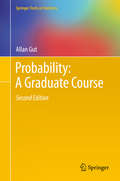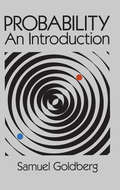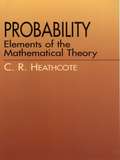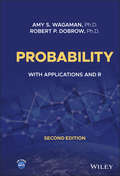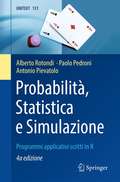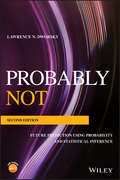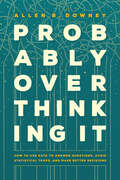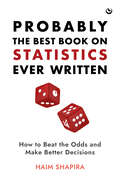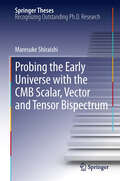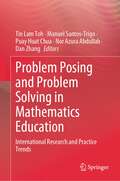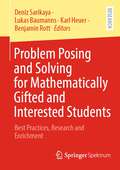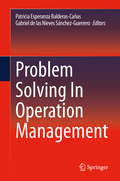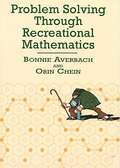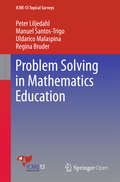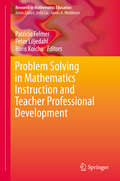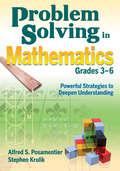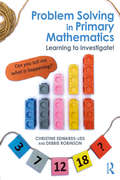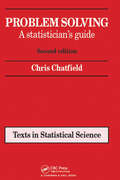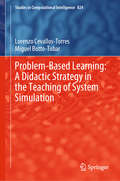- Table View
- List View
Probability: A Graduate Course
by Allan GutLike its predecessor, this book starts from the premise that, rather than being a purely mathematical discipline, probability theory is an intimate companion of statistics. The book starts with the basic tools, and goes on to cover a number of subjects in detail, including chapters on inequalities, characteristic functions and convergence. This is followed by a thorough treatment of the three main subjects in probability theory: the law of large numbers, the central limit theorem, and the law of the iterated logarithm. After a discussion of generalizations and extensions, the book concludes with an extensive chapter on martingales. The new edition is comprehensively updated, including some new material as well as around a dozen new references.
Probability: A Lively Introduction
by Henk TijmsProbability has applications in many areas of modern science, not to mention in our daily life. Its importance as a mathematical discipline cannot be overrated, and it is a fascinating and surprising topic in its own right. This engaging textbook with its easy-to-follow writing style provides a comprehensive, yet concise introduction to the subject. It covers all of the standard material for undergraduate and first-year-graduate-level courses as well as many topics that are usually not found in standard text - such as Bayesian inference, Markov chain Monte Carlo simulation, and Chernoff bounds.
Probability: An Introduction
by Samuel GoldbergExcellent basic text covers set theory, probability theory for finite sample spaces, binomial theorem, probability distributions, means, standard deviations, probability function of binomial distribution, and other key concepts and methods essential to a thorough understanding of probability. Designed for use by math or statistics departments offering a first course in probability. 360 illustrative problems with answers for half. Only high school algebra needed. Chapter bibliographies.
Probability: Elements of the Mathematical Theory
by C. R. HeathcoteDesigned for students studying mathematical statistics and probability after completing a course in calculus and real variables, this text deals with basic notions of probability spaces, random variables, distribution functions and generating functions, as well as joint distributions and the convergence properties of sequences of random variables. Includes worked examples and over 250 exercises with solutions.
Probability: The Classical Limit Theorems
by Henry MckeanProbability theory has been extraordinarily successful at describing a variety of phenomena, from the behaviour of gases to the transmission of messages, and is, besides, a powerful tool with applications throughout mathematics. At its heart are a number of concepts familiar in one guise or another to many: Gauss' bell-shaped curve, the law of averages, and so on, concepts that crop up in so many settings they are in some sense universal. This universality is predicted by probability theory to a remarkable degree. This book explains that theory and investigates its ramifications. Assuming a good working knowledge of basic analysis, real and complex, the author maps out a route from basic probability, via random walks, Brownian motion, the law of large numbers and the central limit theorem, to aspects of ergodic theorems, equilibrium and nonequilibrium statistical mechanics, communication over a noisy channel, and random matrices. Numerous examples and exercises enrich the text.
Probability: Theory and Examples
by Rick DurrettThis book is an introduction to probability theory covering laws of large numbers, central limit theorems, random walks, martingales, Markov chains, ergodic theorems, and Brownian motion. It is a comprehensive treatment concentrating on the results that are the most useful for applications. Its philosophy is that the best way to learn probability is to see it in action, so there are 200 examples and 450 problems.
Probability: Theory and Examples (Cambridge Series in Statistical and Probabilistic Mathematics #49)
by Rick DurrettThis lively introduction to measure-theoretic probability theory covers laws of large numbers, central limit theorems, random walks, martingales, Markov chains, ergodic theorems, and Brownian motion. Concentrating on results that are the most useful for applications, this comprehensive treatment is a rigorous graduate text and reference. Operating under the philosophy that the best way to learn probability is to see it in action, the book contains extended examples that apply the theory to concrete applications. This fifth edition contains a new chapter on multidimensional Brownian motion and its relationship to partial differential equations (PDEs), an advanced topic that is finding new applications. Setting the foundation for this expansion, Chapter 7 now features a proof of Itô's formula. Key exercises that previously were simply proofs left to the reader have been directly inserted into the text as lemmas. The new edition re-instates discussion about the central limit theorem for martingales and stationary sequences.
Probability: With Applications and R
by Robert P. Dobrow Amy S. WagamanDiscover the latest edition of a practical introduction to the theory of probability, complete with R code samples In the newly revised Second Edition of Probability: With Applications and R, distinguished researchers Drs. Robert Dobrow and Amy Wagaman deliver a thorough introduction to the foundations of probability theory. The book includes a host of chapter exercises, examples in R with included code, and well-explained solutions. With new and improved discussions on reproducibility for random numbers and how to set seeds in R, and organizational changes, the new edition will be of use to anyone taking their first probability course within a mathematics, statistics, engineering, or data science program. New exercises and supplemental materials support more engagement with R, and include new code samples to accompany examples in a variety of chapters and sections that didn’t include them in the first edition. The new edition also includes for the first time: A thorough discussion of reproducibility in the context of generating random numbers Revised sections and exercises on conditioning, and a renewed description of specifying PMFs and PDFs Substantial organizational changes to improve the flow of the material Additional descriptions and supplemental examples to the bivariate sections to assist students with a limited understanding of calculus Perfect for upper-level undergraduate students in a first course on probability theory, Probability: With Applications and R is also ideal for researchers seeking to learn probability from the ground up or those self-studying probability for the purpose of taking advanced coursework or preparing for actuarial exams.
Probabilità, Statistica e Simulazione: Programmi applicativi scritti in R (UNITEXT #131)
by Alberto Rotondi Paolo Pedroni Antonio PievatoloIl libro contiene in forma compatta il programma svolto negli insegnamenti introduttivi di Statistica e tratta alcuni argomenti indispensabili per l'attività di ricerca, come le tecniche di simulazione Monte Carlo, i metodi di inferenza statistica, di best fit e di analisi dei dati di laboratorio. Gli argomenti vengono sviluppati partendo dai fondamenti, evidenziandone gli aspetti applicativi, fino alla descrizione dettagliata di molti casi di particolare rilevanza in ambito scientifico e tecnico. Il testo è rivolto agli studenti universitari dei corsi ad indirizzo scientifico e a tutti quei ricercatori che devono risolvere problemi concreti che coinvolgono l’analisi dei dati e le tecniche di simulazione. In questa edizione, completamente rivista e corretta, sono stati aggiunti alcuni importanti argomenti sul test d’ipotesi (a cui è stato dedicato un capitolo interamente nuovo) e sul trattamento degli errori sistematici. Per la prima volta è stato adottato il software R, con una ricca libreria di programmi originali accessibile al lettore.
Probably Not: Future Prediction Using Probability and Statistical Inference
by Lawrence N. DworskyA revised edition that explores random numbers, probability, and statistical inference at an introductory mathematical level Written in an engaging and entertaining manner, the revised and updated second edition of Probably Not continues to offer an informative guide to probability and prediction. The expanded second edition contains problem and solution sets. In addition, the book’s illustrative examples reveal how we are living in a statistical world, what we can expect, what we really know based upon the information at hand and explains when we only think we know something. The author introduces the principles of probability and explains probability distribution functions. The book covers combined and conditional probabilities and contains a new section on Bayes Theorem and Bayesian Statistics, which features some simple examples including the Presecutor’s Paradox, and Bayesian vs. Frequentist thinking about statistics. New to this edition is a chapter on Benford’s Law that explores measuring the compliance and financial fraud detection using Benford’s Law. This book: Contains relevant mathematics and examples that demonstrate how to use the concepts presented Features a new chapter on Benford’s Law that explains why we find Benford’s law upheld in so many, but not all, natural situations Presents updated Life insurance tables Contains updates on the Gantt Chart example that further develops the discussion of random events Offers a companion site featuring solutions to the problem sets within the book Written for mathematics and statistics students and professionals, the updated edition of Probably Not: Future Prediction Using Probability and Statistical Inference, Second Edition combines the mathematics of probability with real-world examples. LAWRENCE N. DWORSKY, PhD, is a retired Vice President of the Technical Staff and Director of Motorola’s Components Research Laboratory in Schaumburg, Illinois, USA. He is the author of Introduction to Numerical Electrostatics Using MATLAB from Wiley.
Probably Overthinking It: How to Use Data to Answer Questions, Avoid Statistical Traps, and Make Better Decisions
by Allen B. DowneyAn essential guide to the ways data can improve decision making. Statistics are everywhere: in news reports, at the doctor’s office, and in every sort of forecast, from the stock market to the weather. Blogger, teacher, and computer scientist Allen B. Downey knows well that people have an innate ability both to understand statistics and to be fooled by them. As he makes clear in this accessible introduction to statistical thinking, the stakes are big. Simple misunderstandings have led to incorrect medical prognoses, underestimated the likelihood of large earthquakes, hindered social justice efforts, and resulted in dubious policy decisions. There are right and wrong ways to look at numbers, and Downey will help you see which are which. Probably Overthinking It uses real data to delve into real examples with real consequences, drawing on cases from health campaigns, political movements, chess rankings, and more. He lays out common pitfalls—like the base rate fallacy, length-biased sampling, and Simpson’s paradox—and shines a light on what we learn when we interpret data correctly, and what goes wrong when we don’t. Using data visualizations instead of equations, he builds understanding from the basics to help you recognize errors, whether in your own thinking or in media reports. Even if you have never studied statistics—or if you have and forgot everything you learned—this book will offer new insight into the methods and measurements that help us understand the world.
Probably Overthinking It: How to Use Data to Answer Questions, Avoid Statistical Traps, and Make Better Decisions
by Allen B. DowneyAn essential guide to the ways data can improve decision making. Statistics are everywhere: in news reports, at the doctor’s office, and in every sort of forecast, from the stock market to the weather. Blogger, teacher, and computer scientist Allen B. Downey knows well that people have an innate ability both to understand statistics and to be fooled by them. As he makes clear in this accessible introduction to statistical thinking, the stakes are big. Simple misunderstandings have led to incorrect medical prognoses, underestimated the likelihood of large earthquakes, hindered social justice efforts, and resulted in dubious policy decisions. There are right and wrong ways to look at numbers, and Downey will help you see which are which. Probably Overthinking It uses real data to delve into real examples with real consequences, drawing on cases from health campaigns, political movements, chess rankings, and more. He lays out common pitfalls—like the base rate fallacy, length-biased sampling, and Simpson’s paradox—and shines a light on what we learn when we interpret data correctly, and what goes wrong when we don’t. Using data visualizations instead of equations, he builds understanding from the basics to help you recognize errors, whether in your own thinking or in media reports. Even if you have never studied statistics—or if you have and forgot everything you learned—this book will offer new insight into the methods and measurements that help us understand the world.
Probably the Best Book on Statistics Ever Written: How to Beat the Odds and Make Better Decisions
by Haim ShapiraTaking an amusing and digestible look at the usually dry world of probability and statistics, this is the ultimate guide to how you can incorporate them into everyday life, from one of the world's most sought-after experts in game theory. This is the only book you need to become a statistics whizz! Numbers are everywhere – food packaging, weather forecasts, social media, adverts, and more. You can&’t escape them. But you can learn to understand them – and avoid being fooled! This book breaks down the key fundamentals in statistics in a fun and accessible way so that you can understand the numbers that occupy your life. • Make sense of sports stats – discover who is the greatest scorer of all time • Learn to interpret scientific studies and how they&’re reported in the media so you&’re never misled again • Discover tips and tricks to make you a more successful gambler • Explore what role stats has to play in flat-earth conspiracy arguments • Read about misunderstood probabilities in the Sally Clarke and OJ Simpson trials With easy-to-follow explanations, tables, graphs, and real-life examples, this book helps you evaluate your options, calculate your chances of success, and make better decisions.
Probing the Early Universe with the CMB Scalar, Vector and Tensor Bispectrum
by Maresuke ShiraishiThe non-Gaussianity in the primordial density fluctuations is a key feature to clarify the early Universe and it has been probed with the Cosmic Microwave Background (CMB) bispectrum. In recent years, we have treated the novel-type CMB bispectra, which originate from the vector- and tensor-mode perturbations and include the violation of the rotational or parity invariance. On the basis of our current works, this thesis provides the general formalism for the CMB bispectrum sourced by the non-Gaussianity in the scalar, vector and tensor-mode perturbations. Applying this formalism, we calculate the CMB bispectra from the two scalars and a graviton correlation and primordial magnetic fields, and then outline new constraints on these magnitudes. Furthermore, this formalism can be easily extended to the cases where the rotational or parity invariance is broken. We also compute the CMB bispectra from the scalar-mode non-Gaussianities with a preferred direction and the tensor-mode non-Gaussianities induced by the parity-violating Weyl cubic terms. Here, we show that these bispectra include unique signals, which any symmetry-invariant models can never produce.
Problem Posing and Problem Solving in Mathematics Education: International Research and Practice Trends
by Dan Zhang Manuel Santos-Trigo Tin Lam Toh Puay Huat Chua Nor Azura AbdullahThis book presents both theoretical and empirical contributions from a global perspective on problem solving and posing (PS/PP) and their application, in relation to the teaching and learning of mathematics in schools. The chapters are derived from selected presentations in the PS/PP Topical Study Group in ICME14. Although mathematical problem posing is a much younger field of inquiry in mathematics education, this topic has grown rapidly. The mathematics curriculum frameworks in many parts of the world have incorporated problem posing as an instructional focus, building on problem solving as its foundation. The juxtaposition of problem solving and problem posing in mathematics presented in this book addresses the needs of the mathematics education research and practice communities at the present day. In particular, this book aims to address the three key points: to present an overview of research and development regarding students’ mathematical problem solving and posing; to discuss new trends and developments in research and practice on these topics; and to provide insight into the future trends of mathematical problem solving and posing.
Problem Posing and Solving for Mathematically Gifted and Interested Students: Best Practices, Research and Enrichment
by Benjamin Rott Deniz Sarikaya Lukas Baumanns Karl HeuerMathematics and mathematics education research have an ongoing interest in improving our understanding of mathematical problem posing and solving. This book focuses on problem posing in a context of mathematical giftedness. The contributions particularly address where such problems come from, what properties they should have, and which differences between school mathematics and more complex kinds of mathematics exist. These perspectives are examined internationally, allowing for cross-national insights.
Problem Solving In Operation Management
by Patricia Esperanza Balderas-Cañas Gabriel de las Nieves Sánchez-GuerreroThis volume examines problem solving and applied systems aimed at improving performance and management of organizations. The book’s eight chapters are integrated into two parts: methodologies and techniques that discuss complex dynamic analysis of the organizations, participative processes for building trend scenarios, consultancy as a systemic intervention process, processes to promote innovative goals in organizations, and analytical processes and solid mathematical representation systems. The authors also include a model to urban parks location, an analytic model to urban services location, and a system to forecast demand with fussy sets.Describes methodologies to analyze processes in complex dynamic organizations, including as participative, interventional, innovative, and analytical approaches;Clarifies a strategies for providing structure to complex organizations and applying analytical methods to decision making;Illustrates problem holistic solving strategies;Explains how to approach several problems from a holistic point of view and how analyze the subjacent processes to make decisions.
Problem Solving Through Recreational Mathematics
by Bonnie Averbach Orin CheinHistorically, many of the most important mathematical concepts arose from problems that were recreational in origin. This book takes advantage of that fact, using recreational mathematics -- problems, puzzles and games -- to teach students how to think critically. Encouraging active participation rather than just observation, the book focuses less on mathematical results than on how these results can be applied to thinking about problems and solving them. Each chapter contains a diverse array of problems in such areas as logic, number and graph theory, two-player games of strategy, solitaire games and puzzles, and much more. Sample problems (solved in the text) whet readers' appetites and motivate discussions; practice problems solidify their grasp of mathematical ideas; and exercises challenge them, fostering problem-solving ability. Appendixes contain information on basic algebraic techniques and mathematical inductions, and other helpful addenda include hints and solutions, plus answers to selected problems. An extensive appendix on probability is new to this Dover edition.
Problem Solving and Data Analysis Using Minitab: A Clear and Easy Guide to Six Sigma Methodology
by Rehman M. KhanSix Sigma statistical methodology using Minitab Problem Solving and Data Analysis using Minitab presents example-based learning to aid readers in understanding how to use MINITAB 16 for statistical analysis and problem solving. Each example and exercise is broken down into the exact steps that must be followed in order to take the reader through key learning points and work through complex analyses. Exercises are featured at the end of each example so that the reader can be assured that they have understood the key learning points. Key features: Provides readers with a step by step guide to problem solving and statistical analysis using Minitab 16 which is also compatible with version 15. Includes fully worked examples with graphics showing menu selections and Minitab outputs. Uses example based learning that the reader can work through at their pace. Contains hundreds of screenshots to aid the reader, along with explanations of the statistics being performed and interpretation of results. Presents the core statistical techniques used by Six Sigma Black Belts. Contains examples, exercises and solutions throughout, and is supported by an accompanying website featuring the numerous example data sets. Making Six Sigma statistical methodology accessible to beginners, this book is aimed at numerical professionals, students or academics who wish to learn and apply statistical techniques for problem solving, process improvement or data analysis whilst keeping mathematical theory to a minimum.
Problem Solving in Mathematics Education
by Peter Liljedahl Regina Bruder Manuel Santos-Trigo Uldarico MalaspinaThis survey book reviews four interrelated areas: (i) the relevance of heuristics in problem-solving approaches why they are important and what research tells us about their use; (ii) the need to characterize and foster creative problem-solving approaches what type of heuristics helps learners devise and practice creative solutions; (iii) the importance that learners formulate and pursue their own problems; and iv) the role played by the use of both multiple-purpose and ad hoc mathematical action types of technologies in problem-solving contexts what ways of reasoning learners construct when they rely on the use of digital technologies, and how technology and technology approaches can be reconciled. "
Problem Solving in Mathematics Instruction and Teacher Professional Development (Research in Mathematics Education)
by Peter Liljedahl Patricio Felmer Boris KoichuRecent research in problem solving has shifted its focus to actual classroom implementation and what is really going on during problem solving when it is used regularly in classroom. This book seeks to stay on top of that trend by approaching diverse aspects of current problem solving research, covering three broad themes. Firstly, it explores the role of teachers in problem-solving classrooms and their professional development, moving onto—secondly—the role of students when solving problems, with particular consideration of factors like group work, discussion, role of students in discussions and the effect of students’ engagement on their self-perception and their view of mathematics. Finally, the book considers the question of problem solving in mathematics instruction as it overlaps with problem design, problem-solving situations, and actual classroom implementation. The volume brings together diverse contributors from a variety of countries and with wide and varied experiences, combining the voices of leading and developing researchers. The book will be of interest to any reader keeping on the frontiers of research in problem solving, more specifically researchers and graduate students in mathematics education, researchers in problem solving, as well as teachers and practitioners.
Problem Solving in Mathematics, Grades 3-6: Powerful Strategies to Deepen Understanding
by Alfred S. Posamentier Stephen KrulikWith sample problems and solutions, this book demonstrates how teachers can incorporate nine problem solving strategies into any mathematics curriculum to help students succeed.
Problem Solving in Primary Mathematics: Learning to Investigate!
by Debbie Robinson Christine Edwards-LeisProblem Solving in Primary Mathematics is an essential text designed to support new and experienced teachers in guiding pupils through mathematical investigations and problem solving, offering a framework that children themselves can begin to adopt as they progress to greater metacognitive awareness. Underpinned by the latest international research and theory, it examines how individual pupils think and act differently and offers guidance on how to promote independence and autonomy in the classroom. It examines key topics such as: Preparing for mathematical learning Designing learning material Assessing and evaluating learning Identifying key points for intervention What to do when learning is stalled Critical numeracy for real-world problem solving Mental Model Theory and the Mental Model Mode Different approaches to problem solving and investigating Aimed at new and experienced educators, particularly those with a maths specialism, and illustrated with investigations and activities, Problem Solving in Primary Mathematics demonstrates how frameworks can be used in key mathematical areas and assists students in progressing towards more meaningful problem solving.
Problem Solving: A statistician's guide, Second edition (Chapman & Hall/CRC Texts in Statistical Science)
by Chris ChatfieldThis book illuminates the complex process of problem solving, including formulating the problem, collecting and analyzing data, and presenting the conclusions.
Problem-Based Learning: A Didactic Strategy in the Teaching of System Simulation (Studies in Computational Intelligence #824)
by Miguel Botto-Tobar Lorenzo Cevallos-TorresThis book describes and outlines the theoretical foundations of system simulation in teaching, and as a practical contribution to teaching-and-learning models. It presents various methodologies used in teaching, the goal being to solve real-life problems by creating simulation models and probability distributions that allow correlations to be drawn between a real model and a simulated model. Moreover, the book demonstrates the role of simulation in decision-making processes connected to teaching and learning.
